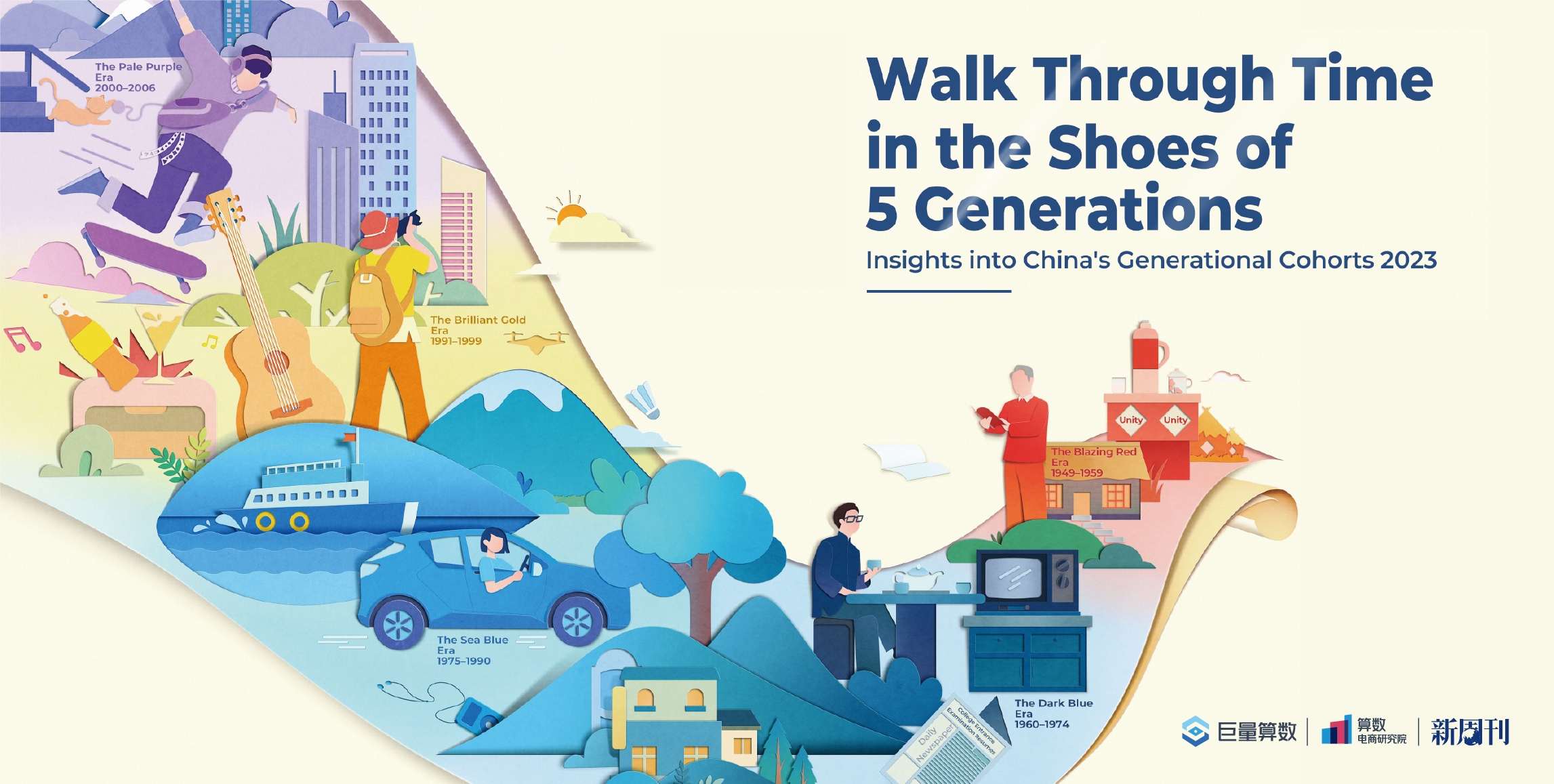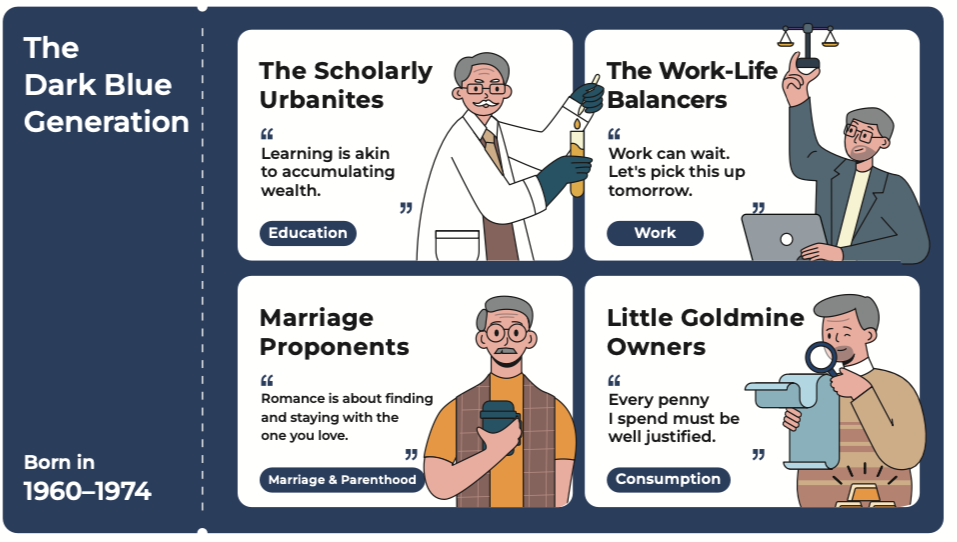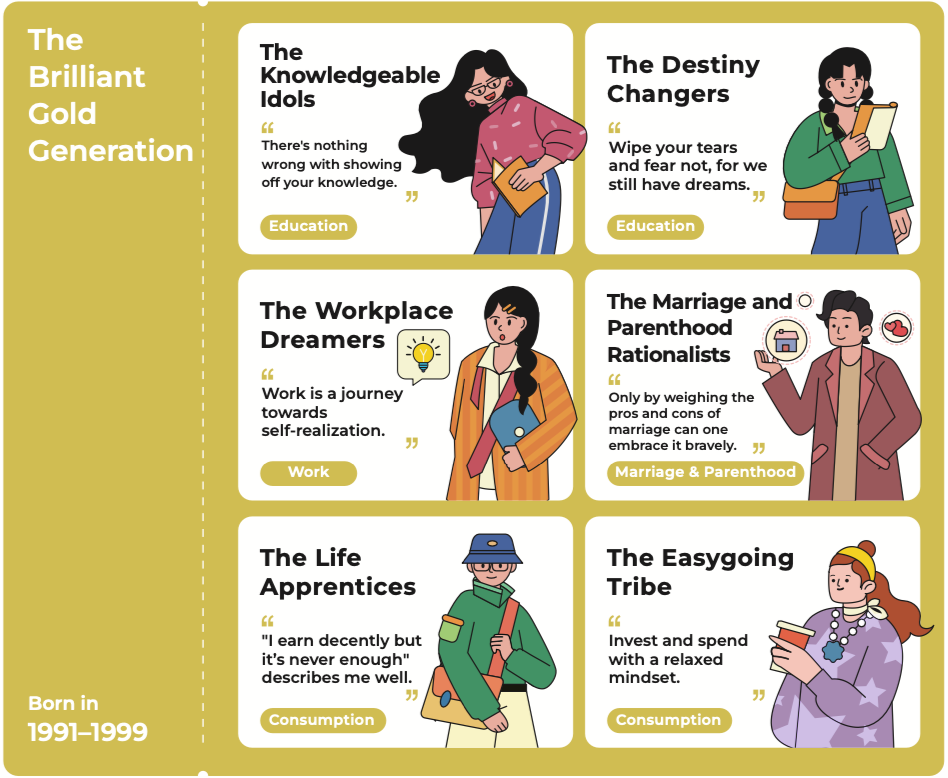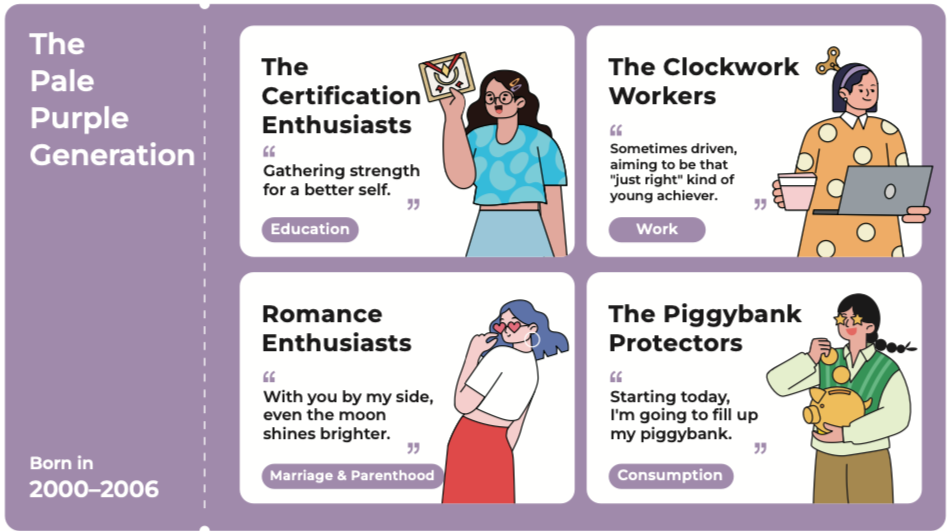
What are the Generational Cohort Groups and Names in China?
While successful brands know how to capture market share by understanding demographic diversity, many brands fail to grasp the subtleties of China’s vast population. At best, they perceive China as a nation stratified by urbanization tiers based on city size, and at worst, they oversimplify China into a singular, monolithic market.
With countless brands vying for market share, an in-depth understanding of China’s unique generational cohorts can offer immediate business insights and build a connection between brands and consumers.
China’s unique generational structure
China’s population and age structure are constantly shifting and impacting social and economic patterns, with generational differences a clear sign of demographic changes.
To understand generational differences in consumption and spending habits, social science studies and classification models provide a useful point of reference. The “Generation X/Y/Z” classification model, for example, is widely used in China (especially with the term “Gen Z” frequently appearing in the press). However, this model is contextually aligned with Europe and the US, with a notable emphasis on the explosion of information media.
Generation Y, for example, is commonly defined as those born between 1981 and 1996, a generation that experienced the popularization of computers and the Internet. However, according to statistics from the China Internet Network Information Center, China’s Internet penetration rate was less than 9% in 2005. In comparison, data from the Pew Research Center shows that the Internet penetration rate in the US reached 47% that same year.
Another common point of reference is the decade-based classification model (often expressed as ’80s/’90s/’00s). While this method of classification is easy to understand, cutoff points between generations fail to capture the impact of historical events, social factors, and common characteristics.
Clearly, China needs a generational classification system that incorporates a broader range of factors that align with its own local context. Answering the gap in generational research, Ocean Insights and New Weekly published a joint study to decipher generational values reflected in China’s changing age structure.
The aim of their research is to help different industries understand the unique needs of generational cohorts in Chinese and support the creation of more user-friendly products and services that meet the needs of each generational cohort.
A new generational classification model for China
In designing their study, Ocean Insights and New Weekly determined that, in addition to historical events and advances in information media that are common in conventional classifications, it was crucial to consider China’s overall stage of economic development and the backdrop of people’s formative years (ages 12-30).
By anchoring their generational classifications on these four factors, Ocean Insights and New Weekly identified 20 common generational cohorts that have emerged since the establishment of the People’s Republic of China in 1949.

These 20 generational cohorts straddle 6 generations, each with their unique representative colors, reflecting the spirit of the times. Ocean Insights and New Weekly also merged their cohort model with big data from Douyin’s ecosystem to extract their basic profiles, content preferences, and decision-making psychology, which we’ll dive into here in this post.
Blazing Red (1949-1959)
The fervent, determined, and resolute nature of red, along with its symbolic representation of patriotism, aligns perfectly with the establishment of the People’s Republic of China in 1949 and the character traits of this generation.

Generational characteristics
The Blazing Red Generation experienced the most passionate yet arduous era in modern Chinese history. From the late 1950s to the late 1970s, approximately 20 million educated youths were sent to the countryside. Access to resources was scarce, which was particularly evident in the 1960s when China had tense relations with both the US and the Soviet Union. Diligence and frugality thus become common traits of this generation.
The isolation factor of rural areas helped to preserve traditional customs, and with radio as the main form of mass media, the Blazing Red Generation had minimal access to Western ideas and the outside world.
As this generation now enters their elderly years, they are relieved of family responsibilities and are beginning to “emphasize themselves” more by expanding their interests, such as fishing, chess, travel photography, and even Yangko dancing. The generation that dedicated their youth to their motherland is now finally free to live their own lives.
Generational cohorts
The Wise Veterans: Mostly older men from higher-tier cities, the Wise Veterans have retired from successful careers and are rich in experience. They are open to learning but not very receptive to new things.
On Douyin, they enjoy casual and plot-driven content and follow retirement-related commercial content. Notably, they are adept at using search engines for information.
The Family Enthusiasts: Marked by traditional thinking, the Family Enthusiasts have a higher proportion of males and include many from rural backgrounds. They prefer to follow the traditional life course of marrying and having children.
On Douyin, they focus on family-related content and are avid fans of livestreams. They are especially attentive to cost-effectiveness and are keen on investing in their children’s education and development.

Dark Blue (1960-1974)
The dedication of workers, represented by their dark blue work uniforms, is an iconic symbol of the industrial era prior to China’s reform and opening up and an ideal color for our second cohort.

Generational characteristics
While material supplies became more abundant during the formative years of the Dark Blue Generation, they remained relatively limited. This was especially true in the early 1980s when food stamps were still in use. At the same time, the “more work, more pay” labor-based distribution system was implemented. These factors made the Dark Blue Generation resilient, hardworking, and frugal.
China’s urbanization rate was only 19% during the early period of reform and opening up, and the majority of the Dark Blue Generation had experience living in rural areas that adhered to traditional values.
The dominant media during this period was print and although newspapers featured a variety of opinions, they still mainly functioned as a unidirectional communication channel, making it difficult to impact traditional values.
The resumption of the college entrance examination gave the Dark Blue Generation the opportunity to reshape their destinies. Although the admission rate was only 4.7%, it meant that a university diploma was highly valued. These talents not only proved themselves but also became leaders in various industries, deeply involved in the process of industrialization.
Moreover, the Dark Blue Generation was among the first to enjoy the benefits of reform and opening up, including welfare housing distributions, re-education opportunities, and more abundant material supplies.
Currently, this generation has reached the age of 49 and above. Retirement life is approaching for the female members of this generation. Aside from the eager anticipation of raising their grandchildren, their remaining time is dedicated to expanding their personal interests and fulfilling the dreams of their youth.
Generational cohorts
The Scholarly Urbanites: The Scholarly Urbanites mostly live in high-tier cities, with a greater male presence. They’re influential in their own circles and value education as a life-shaping force.
On Douyin, they engage with current affairs and lifestyle content, favor spending in content scenarios, and take an active part in holiday marketing. They value not just cost-effectiveness but also the convenience of purchasing channels.
The Work-Life Balancers: Middle-aged and mostly male with a stable job, Work-Life Balancers value their work but are not overly ambitious. They seek a balance between work and life and prefer stable income and structured tasks.
On Douyin, they follow food and leisure topics. Aside from lifestyle-related commercial content, they also have a strong interest in finance.
The Marriage Proponents: Compared to other generations, this cohort is most receptive to arranged marriages and generally doesn’t fear getting married.
Driven by family responsibilities, they invest heavily in their children’s education and prioritize the quality of products. On Douyin, they follow mainstream lifestyle and leisure content.
The Little Goldmine Owners: Growing up during the era of economic reform and a booming market economy, this cohort is now in their prime earning years. With a family-focused mindset, they tend to spend rationally.
On Douyin, they’re interested in food, parenting, real estate, and finance. Studies have found that they tend not to actively search for things to buy and that they need help understanding the market. Their spending potential shouldn’t be overlooked.

Sea Blue (1975-1990)
After China made the decision in 1992 to establish a socialist market economic system, many workers migrated to coastal provinces in search of entrepreneurial opportunities. The literal meaning of the word “coastal” and the figurative meaning of the phrase “heading out to sea (venturing into business)” meant that the color sea blue was fitting and its symbolism of courage and exploratory spirit also fit with the characteristics of this generation.

Generational characteristics
Starting in 1992, most of China’s state-owned enterprises underwent shareholding system reforms and rational changes to employee management. This resulted in many workers being laid off, leading many in this generation to venture into business and move to coastal areas such as Guangdong. The characteristics of daring to take risks, striving for success, and being tenacious summarize the spirit of the Sea Blue Generation.
As with previous generations, the Sea Blue Generation inherited the traditions of diligence and frugality. They cherish their hard-earned money, especially as they remember childhood experiences when their parents earned only a few dozen RMB in monthly wages.
Television was the mainstream media during the Sea Blue Generation’s youth period, and while it remains a unidirectional form of communication, it helped to broadcast more diverse content. Similarly, the “DVD rental craze” during this time exposed people to more cultures, ideas, and ways of living. The Web 1.0 era also unfolded during the Sea Blue Generation’s early growth stage, with web portals, community forums, and blogs emerging online.
Generational cohorts
Avid learners: The Avid Learners come from a wide range of professions and now form the backbone of society. They’re mature and wise, highly value lifelong learning, and are open to all kinds of ways to learn.
On Douyin, they gravitate towards content related to culture and technology, and also show a strong interest in commercial content regarding personal care, fashion, and beauty.
The Career Strivers: Career Strivers believe that hard work pays off and because they are ambitious about climbing the career ladder, they don’t mind working overtime. They also value family time and pay close attention to their mental health.
On Douyin, they are drawn to finance and culture-related content and are interested in topics like fashion, auto, and beauty. They also favor livestreams and purchasing during holiday-based promotions.

The Homebodies: The Homebodies have a stable job and a clear life philosophy. They look forward to marriage and love being around kids.
On Douyin, they’re attracted to down-to-earth content, care about the quality of life, and make time for livestreams. Their searches often lead to purchases related to child education and personal improvement. In addition, they actively participate in holiday marketing events and always look for products that are cost-effective and safe.
The Chief Rationalist Officers: More common in top-tier cities, this cohort spends boldly but wisely, especially on major purchases. Besides investing in their children’s education, they like to spend on hobbies and leisure. Their expenditure is among the most balanced across generations.
On Douyin, they engage with content related to real estate, finance, education, and investment, and make time for shopping in Douyin livestream rooms. They’re active in both holiday marketing events and product-purchasing scenarios.

Brilliant Gold (1991-1999)
In 2008, the successful hosting of the Beijing Olympics and topping the gold medal tally for the first time reflected China’s strength as a nation. The dazzling color of the gold medals formed a collective memory of that time. Along with China’s economic boom, the phrase “Golden Age” was widely mentioned across various industries and this confidence and pride, represented by the color gold, is closely intertwined with this generation’s personality.

Generational characteristics
While the traits of resilience, tenacity, and emphasis on tradition linger on in the Brilliant Gold Generation, there are stronger signs of self-awareness. The advent of Web 2.0, in particular, created new channels for self-expression and the opportunity for a single viewpoint to attract broader support.
It’s important to note that China’s total GDP surpassed Japan to become the world’s second-largest economy during the formative years of this generation. This rise in prosperity provided greater access to entertainment, including games, movies, and concerts.
Conversely, factors like rising housing prices make this generation feel partly at a loss, while stress and internal contradictions have shaped their multi-faceted personalities. They tell their parents they want to get married and have children, tell peers they prefer the freedom of being single, assure their bosses they will work hard, and tell their former colleagues they can no longer endure another day of work.
Generational cohorts
The Knowledgeable Idols: Mostly women, the Knowledgeable Idols are usually entrepreneurs and educators with a constant thirst for knowledge.
On Douyin, they follow educational content and content related to movies, culture, fashion and beauty. They have a high regard for influencers and are easily swayed by opinion leaders.
The Destiny Changers: Destiny Changers are facing lots of changes and constantly trying to fit in. Many are either climbing up in their careers or finishing up advanced studies.
On Douyin, they lean towards content related to current affairs and technology as well as auto-related content. Their spending is well-balanced between content and product scenarios, and they have a high regard for KOLs.
The Workplace Dreamers: Workplace Dreamers are mostly women with high education levels who view their careers as a pathway to fulfill personal aspirations.
On Douyin, they enjoy TV dramas and other entertainment content and are somewhat materially ambitious. They prioritize value for money and brand reputation in their purchases and don’t hesitate to spend on their hobbies.
The Marriage and Parenthood Rationalists: This cohort is well-educated and approaches love, marriage, and parenthood with a balanced and rational perspective.
On Douyin, their interests lean towards “therapeutic” content like relationship stories and food. They are active in both content and product scenarios, with a strong inclination to research and evaluate products from multiple angles before making a purchase.
The Life Apprentices: Many in this cohort work in private enterprises but are feeling the pinch financially, despite incomes at or above the modal level. They invest in self-improvement and leisure activities but opt out of proactive financial investments, and occasionally indulge in aspirational purchases.
On Douyin, they show a keen interest in lifestyle content, especially in leisure and entertainment. They have high demands for personalized consumption and are willing to establish trust with brands and KOLs.
The Easygoing Tribe: The Easygoing Tribe typically doesn’t have a clear pattern when it comes to consumer behavior, oscillating between emotional and need-based purchases.
On Douyin, they’re deeply interested in lifestyle content and find joy in ordering takeout and binge-watching from home. Cost-effectiveness and safety are key considerations in their decisions.

Pale Purple (2000-2006)
Beginning in 2017, China achieved major milestones in advanced fields including aerospace and 5G technology. However, these achievements have dovetailed with the persistence of multiple uncertainties, including trade frictions, closed borders, and the COVID-19 pandemic. This complex backdrop has formed a complex generation: one that still carries passion and patriotism represented by red, the open-mindedness of blue, and the confusion of entering a complex society, symbolized by white. This combination of colors produces pale purple, a color that is both mysterious and highly individualistic in nature.

Generational characteristics
The Pale Purple Generation is the most complex. Empowered by the prevalence of social media, they have a strong sense of self-awareness and a tendency to express themselves directly. When it comes to macro issues, they often align with mainstream views and actively voice positive opinions that express patriotism while carrying a personal touch.
For this generation now entering adult society, many uncertainties have made them feel lost. However, they are still full of hope, with 70% believing that “their future will become increasingly better.”
As those born in and after 2007 gradually enter adulthood, the size of the Pale Purple Generation will continue to grow until the next generational anchor is identified.
Generational cohorts
The Certification Enthusiasts: The Certification Enthusiasts are predominantly female and eager to move quickly along professional paths, which drives them to strive for tangible outcomes like professional qualifications, civil service jobs, and academic achievements.
On Douyin, they follow campus and entertainment content as well as consumer trends. They also like to establish positive relationships with brands and KOLs, while being tech enthusiasts is another facet of their identity.
The Clockwork Workers: Women constitute the majority of this cohort, with many in their first 1-3 years of professional life. They accept the idea of winding themselves up to slowly advance, as long as it doesn’t upset their work-life balance!
On Douyin, they show a preference for academic and ACGN content. Their consumption is balanced between content and products. They also have a keen eye for aesthetics.
The Romance Enthusiasts: The Romance Enthusiasts are predominantly female, most with higher education and in the midst of their studies or freshly graduated. They often harbor big dreams about love, but marriage and starting a family are still topics for the distant future.
On Douyin, they focus on leisurely content geared toward young people. Fashion and beauty are their key areas of spending, and they have a notable presence in holiday marketing events. They’re open to product recommendations but are also clear about what they want to buy.
The Piggybank Protectors: The Piggybank Protectors may not have substantial savings or financial experience, but they understand that accumulating wealth is a marathon, not a sprint, and have cultivated the habit of saving. Even so, they often indulge in purchasing pleasure and show no strong desire for major investments like real estate.
On Douyin, they enjoy heartwarming animal videos and keep up with trendy content. As prudent consumers, they prefer a more “consumer-led” shopping experience, with design a major factor.

Common traits across generations
Having looked at each of the 6 major groups and the 20 intragenerational cohorts found within these generations, we can now take a step back to admire the shifts and common traits between them, starting with their attitude toward spending.
- Conservative spending: All generational cohorts are relatively conservative in terms of consumption and exhibit a clear inclination toward saving money.
- Sense of tradition: The initial shift in mindset with regard to tradition and self-expression occurs between the Sea Blue Generation and the Brilliant Gold Generation, characterized by the transition from “emphasis on tradition” to “self-emphasis.”
- Opinions: Younger generations show more diversity in their perspectives on the same issue, while older generations tend to have more uniform opinions.
- Curiosity: Younger generations like to conduct searches, and this inclination becomes more pronounced with decreasing age.
Summarizing the above characteristics, it’s fair to say that Chinese consumers, as a whole, are relatively conservative. That said, consumer awareness is shifting from traditional family-oriented values to more individualistic ones, and the younger the generational cohort, the clearer they understand their preferences.
Tracking future changes in generational cohorts
Generational cohorts are dynamic and constantly evolving. With time, the size of the older generations will naturally diminish, while the size of younger generations will continue to expand in proportion.
As the Pale Purple Generation forms the backbone of society, their values and behaviors will transform society, impacting themselves and other generations. As observed in the study, when different generations confront the same life issues, their choices progressively diverge.
As the younger generational cohorts take center stage, audience asset management, native advertising, and personalized matching from a long-term perspective will become the focus of future marketing and business operations.
While the future is yet to play out, many changes are brewing or waiting in clear sight, and for brands, monitoring generational cohorts serves as a crucial window to the future. By tracking the ongoing changes in generational cohorts, brands can enhance the foresight of their business strategies and grasp the opportunity to unlock future value.
To access more in-depth analysis regarding generational cohorts, including their content preferences, case studies, and other critical data, you can read the full report here.



